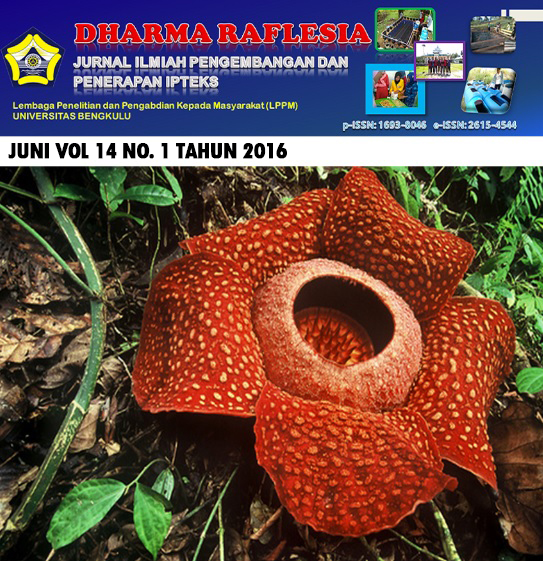Main Article Content
Abstract
Strengthening food security can be started at the household level, one way is through the program Sustainable Food House (RPL). Sustainable Food Houses Program in urban residential areas is one way of creative, innovative and environmentally friendly to realize the green area in the yard of a residential beautiful, cool and productive. How this is done by utilizing the pot wheelbase (wick pot) on a semi-organic vegetable production. IbM activities of community groups to inspire citizens and public housing complexes around the housing to apply RPL through the pot wheelbase in the cultivation of vegetables in home gardens urban areas. Utilization of open space with vegetable crops, in addition to economic value, it also creates a healthy and educational environment for the citizens housing complex BTN Hope and Housing Development UNIB. The results of the activities IbM the RPL program is able to evoke the spirit of the citizens in an effort to greening the housing area. This is evidenced by the use of the home page and all along the road on both the housing. It also provides technical skills of residents in the cultivation of vegetables in the pot so that the need for some types of vegetables for his family adequately met from the application of science and technology activities for the community by a team of professors from the University of Bengkulu.
Keywords: green areas, sustainable food home, wick pot, vegetables
Article Details
- Authors retain copyright and grant the journal right of first publication with the work simultaneously licensed under a Creative Commons Attribution-ShareAlike 4.0 (CC BY-SA) that allows others to share the work with an acknowledgement of the work's authorship and initial publication in this journal.
- Authors are able to enter into separate, additional contractual arrangements for the non-exclusive distribution of the journal's published version of the work (e.g., post it to an institutional repository or publish it in a book), with an acknowledgement of its initial publication in this journal.
- Authors are permitted and encouraged to post their work online (e.g., in institutional repositories or on their website) prior to and during the submission process, as it can lead to productive exchanges, as well as earlier and greater citation of published work (See The Effect of Open Access).
- This work is licensed under a Creative Commons Attribution-ShareAlike 4.0 International License.
References
- Bainbridge, D.A., 2007, A Guide for Desert and Dryland Restoration, Island Press. Eliades, A., 2010, Deep Green Permaculture, www.deepgreenpermacuture.com. Kementerian Pertanian, 2011, Pedoman Umum Model Kawasan Rumah Pangan Lestari,Jakarta.
- Lehman, J., 2007, Bio-Char Soil Management on Highly Weathered Soils in The Humid Tropics. J.Plant Nutr. Soil, p 112-121.
- Perazzini, S., 2012, How to Keep Your Potted Plants Alive While You Are Away. www.remuerarealestateregister.co.nz.
- Rachman, H.P.S., dan M. Ariani, 2007, Penganekaragaman Konsumsi Pangan di Indonesia: Permasalahan dan Implikasi untuk Kebijakan dan Program, Makalah pada “Workshop Koordinasi Kebijakan Solusi Sistemik Masalah Ketahanan Pangan Dalam Upaya Perumusan Kebijakan Pengembangan Penganekaragaman Pangan“, Hotel Bidakara, Jakarta, 28 November 2007, Kementerian Koordinator Bidang Perekonomian Republik Indonesia.
- Simatupang, P., 2006, Kebijakan dan Strategi Pemantapan Ketahanan Pangan Wilayah. Makalah Pembahas pada Seminar Nasional “Pemasyarakatan Inovasi Teknologi Pertanian Sebagai Penggerak Ketahanan Pangan Nasional” Kerjasama Balai Besar Pengkajian dan Pengembangan Teknologi Pertanian, Balai Pengkajian Teknologi Pertanian NTB dan Universitas Mataram, Mataram 5-6 September 2006.
- Undang-Undang Republik Indonesia Nomor 18 Tahun 2012 Tentang Pangan.
References
Bainbridge, D.A., 2007, A Guide for Desert and Dryland Restoration, Island Press. Eliades, A., 2010, Deep Green Permaculture, www.deepgreenpermacuture.com. Kementerian Pertanian, 2011, Pedoman Umum Model Kawasan Rumah Pangan Lestari,Jakarta.
Lehman, J., 2007, Bio-Char Soil Management on Highly Weathered Soils in The Humid Tropics. J.Plant Nutr. Soil, p 112-121.
Perazzini, S., 2012, How to Keep Your Potted Plants Alive While You Are Away. www.remuerarealestateregister.co.nz.
Rachman, H.P.S., dan M. Ariani, 2007, Penganekaragaman Konsumsi Pangan di Indonesia: Permasalahan dan Implikasi untuk Kebijakan dan Program, Makalah pada “Workshop Koordinasi Kebijakan Solusi Sistemik Masalah Ketahanan Pangan Dalam Upaya Perumusan Kebijakan Pengembangan Penganekaragaman Pangan“, Hotel Bidakara, Jakarta, 28 November 2007, Kementerian Koordinator Bidang Perekonomian Republik Indonesia.
Simatupang, P., 2006, Kebijakan dan Strategi Pemantapan Ketahanan Pangan Wilayah. Makalah Pembahas pada Seminar Nasional “Pemasyarakatan Inovasi Teknologi Pertanian Sebagai Penggerak Ketahanan Pangan Nasional” Kerjasama Balai Besar Pengkajian dan Pengembangan Teknologi Pertanian, Balai Pengkajian Teknologi Pertanian NTB dan Universitas Mataram, Mataram 5-6 September 2006.
Undang-Undang Republik Indonesia Nomor 18 Tahun 2012 Tentang Pangan.
